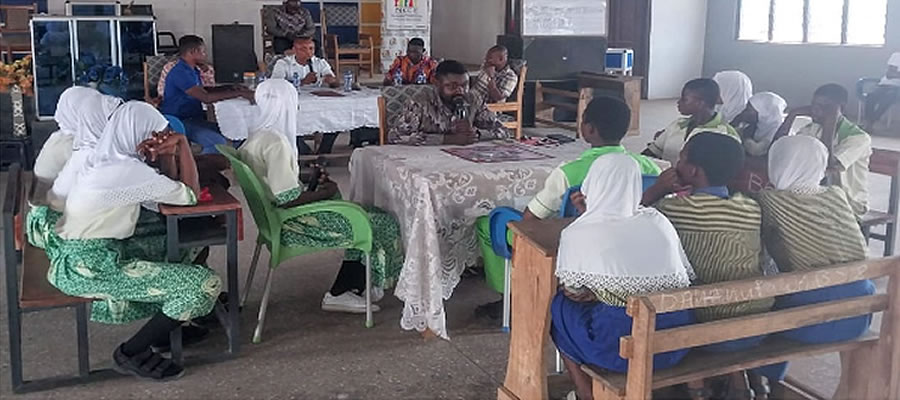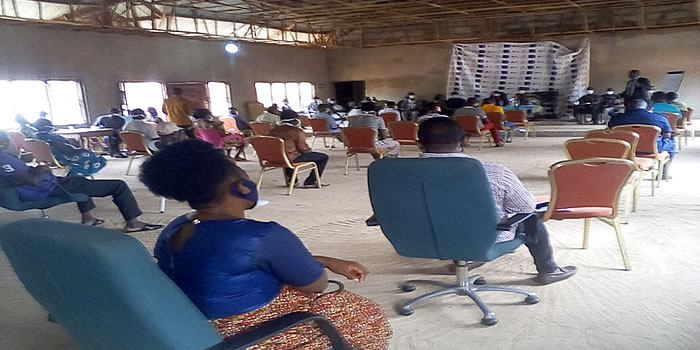

Health Care
The Pru West District has no hospital but served by a number of health facilities mostly public, a lot of successes were chalked in some of the indicators identified for tracking the performance of the sector. Concerted efforts still need to be put in place to improve the health delivery challenges in terms of access, quality and affordability in the District.
Incidence of Diseases in the District
Figure 1.16: Top ten causes of OPD Attendance
Source: PDA, District Health Department, 2017
Figure 1.17: A Three Year Trend of OPD Attendance
There has been a drastic decline in OPD attendance in the urban areas from the year 2015 to 2016 which is greatly affected by the sub-districts since it has the chunk of the population and also its there the district hospital is situated.
Table 23: Top ten causes of Mortality in 2016
Overwhelming sepsis leads the top ten (10) causes of death with 31 cases representing (12.1%) with Hypovolemic shock been the last with 9 representing 3.5%
Source: PDA, District Health Department, 2017
Health Care Infrastructure
Table 25: Sub-District, Hospitals, Health Centres, CHPS Zones and CHPS Compounds
The District has 8 health care facilities made up of; three (3) Health Centres and five (5) CHPS compounds. Besides these, a total of about 30 Traditional Birth Attendants have been identified and trained.
Health Care Professionals
The District is served by the Pru East Hospital as at 2017 with 9 Doctor 125 Nurses, 6 Dispensing professionals,10 Laboratory Technicians, 5 Medical Record Technician and 9 Disease Control Officers. The Doctor patient ratio for the District is therefore 1:28,960 as compared to the national ratio of 1: 925. The Nurse patient ratio is however 1: 1,392. This analysis is however based on the entire Pru District. Data on the new district is yet to be analyzed.
Access to Health Care Facilities
The existing number of facilities in the District clearly indicates that some communities have low access to health care facilities. According to data from the 2013 Core Welfare Indicators Questionnaire survey, about 32.3% of households are within the reach to the nearest health facility as compared to the regional average of 53.85%.+
A look at the number of facilities simply portrays that accessibility to health care facilities are mainly Health Centres, Community Clinics and Traditional healers. This is in view of the fact that these facilities are somewhat distributed among the major centres at Zabrama, Abease, Prang, Parambo. In terms of distance from nearest health facility to localities, 92.7% of the localities in the District have traditional healers, thus seek treatment from them whereas 2.8% of the population have clinics within their locality, compared 0.7% to hospitals.
The trend of accessibility to health care therefore calls for prudent measures to identify and register them according to the treatment of ailment. Similarly, the review of the health insurance scheme policy to include traditional healers is highly recommended.
Infant Mortality Rate
Table 26: Under Five (5) Mortality Trend in Pru District by Months and Years, (2013-2016)
Looking at the trend by months, August and November registered the highest being 13 and 14 respectively in the year under review.
Figure 1.18: Trend of mortality rate
The trend of mortality rate decreasing from as compared to the previous year 2015 but still relatively high as compared to 2014 and 2013
Figure 1.19: MATERNAL MORTALITY
Source: District Health Department, 2017
During the year under review 4 maternal death were recorded even though there was an increase from previous year it is still below the median performance. Strategies will be implemented in the coming year to reduce it
Antenatal Care
Antenatal clinics were held in all health institution with exception of some private clinics. The district has the objective of providing quality focus antenatal care to all pregnant women in the district.
Figure 1.20: ANC performance
ANC registrants for 2016 was 5,955 representing 99.9% of the expected pregnancies in the district.
Total pregnant women making 4+ visit is 5,307 (89.1%) with average antenatal visit per client at 4.2. This shows that majority of our mother have the minimum contact required during pregnancy in the district.
HB check at registration was 5236 (87.9) with 1754(33%) below.
Supervised Deliveries in the District
These are deliveries conducted by trained health personnel (midwives, trained nurses and doctors). The primary aim is to reduce maternal mortality, disability and injury during childbirths. Table 1.22 below presents the trend of supervised deliveries over 3 year period.
Figure 1:21: Trend of Supervised Deliveries
A total of 3985 (66.7%) delivery was supervised by a trained personnel which is an improvement on the previous year even though is still below national target of 80% this is because about half of the district population resides at the overbank which make traveling from there to deliver at the hospital not only tedious but also very expensive since most of them have to hire a boat from their location to the hospital leading to high home delivery. Special programme will be design to help address the needs of the overbank client. Also CHPS compound with other special packages will be employed to attract staff to these places to render service.
Figure 1.22: Location of Health Facilities
Status of the District Mutual Health Insurance Scheme The National Health Insurance programme is a social protection programme that seeks to ensure that all residents of Ghana access quality health care without paying money at the point of service. The enrolment figure for the year under review was at 49,896. This represents 32% of the total projected population of the district.
Registration of members of the scheme is a year round affair which was done alongside with renewals of old members. In 2016, the scheme enrolled 49,896 as against 27,775 in 2015 indicating an increase in registration (22,121).
Table 27: Registration and Renewals of NHIS as at December, 2016
A Three Year Trend of OPD
Attendance by Insured and Non-Insured Out of the total 148459 OPD attendances, those insured were 137496 (92.6%) and those without insurance were 10963 (7.4%).
There is a three year trend of increase in that of insured whiles non-insured increased from 2013 to 2014 but decreased from 2014 to 2015.
Figure 1.25: Trend of comparing insured and Non-Insured, 2014-2016
Clients accessing facilities in the district insured, increased from 2014 to 2015 and decreased from 2015 to 2016 whiles non-insured decreased from 2014 to 2015 and increased slightly in 2016
NUTRITION SECURITY
Malnutrition and undernourishment not only reduces a person?s immune system, but also makes the individual more vulnerable to diseases, negatively affects a child's cognitive abilities and educational performance and eventually reduces their productivity as working adults. Household earnings therefore stagnate and/or decline, affecting their welfare, reducing the potential of and adding to the burden of District's economy. If the District is to increase the pace of economic development, there must be a strong focus on investing in the nutrition of its people, particularly women and children who currently carry the highest burden of malnutrition.
Among others the District will encourage food fortification and diet diversification to improve diet quality, Provide Iron and Folate supplements for women preconception and during pregnancy, Carry out awareness creation to reduced consumption of foods high in fat, saturated fat, salt and sugar, Promote safe water, sanitation and hygiene (WASH) to limit infections that lead to reduced iron absorption, Promote early initiation of and 6 months exclusive breastfeeding, Incorporate explicit nutrition objectives and indicators into social protection programmes etc.
Date Created : 7/14/2023 12:00:00 AM










 facebook
facebook
 twitter
twitter
 Youtube
Youtube
 +233 593 831 280
+233 593 831 280 0800 430 430
0800 430 430 GPS: GE-231-4383
GPS: GE-231-4383 info@ghanadistricts.com
info@ghanadistricts.com Box GP1044, Accra, Ghana
Box GP1044, Accra, Ghana